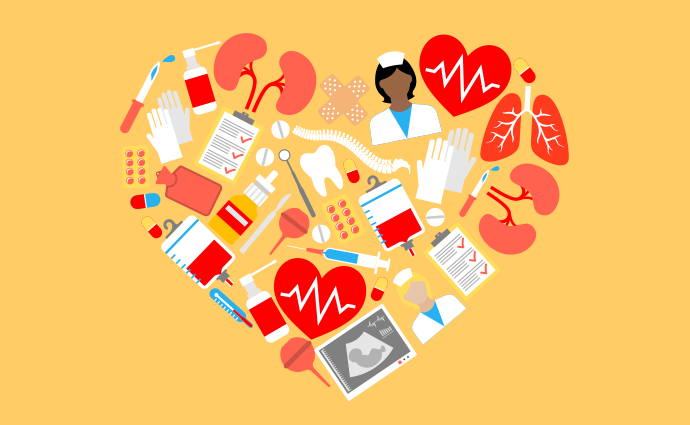Why are there more and more cerebral infarctions in China, but fewer in the United States? Doing these 2 points is more important than folic acid supplementation
Why are there more and more cerebral infarctions in China, but fewer in the United States? Doing these 2 points is more important than folic acid supplementation
With the continuous improvement of living standards, many friends have found that more and more people suffer from strokes around. It is not surprising to have such feelings. According to the survey report released in 2017, stroke has become our disease. The leading cause of death, and ischemic heart disease and cancer can only rank second or third. In a cross-sectional survey of the burden of stroke disease in China published in the journal Circulation, it was pointed out that the standardized prevalence rate of stroke among people over 40 years old rose from 1.89% in 2012 to 2.19% in 2016 In other words, the incidence of stroke in China is still on the rise.
As for the data from the developed countries in the United States, relevant research data shows that the incidence of stroke in the United States has seen an inflection point in the last century. An article published in JAMA in 2014 analyzed the arteries of the American community from 1987 to 2011. The development trend of stroke incidence and mortality among different ethnic groups in the atherosclerosis risk cohort. From the overall data analysis, the incidence and mortality of stroke in the United States are showing a downward trend. The overall incidence of stroke in the study is 3.73 per 1,000 people per year.
Although the two sets of survey data in China and the United States are not comparable, the incidence of stroke in China is still on the rise, while it is an indisputable fact that the incidence of stroke in developed countries such as Europe and the United States has been declining year by year. It was published in 2019. A global stroke burden estimation study in The Lancet Journal of Neurology also pointed out that the global average lifetime risk of stroke is 24.9%, while the lifetime risk in China is as high as about 40%.
Some of these big data statistics tell us that the Chinese people’s stroke risk is higher than that of developed countries and also higher than the world average. Why is there such a difference? Some popular science articles emphasized that it is because the United States has been strengthening folic acid supplementation many years ago, and therefore, the incidence of stroke in the United States has been declining year by year. For some people, folic acid supplementation is indeed an important means to effectively reduce the risk of stroke, but not for the prevention of stroke risk. Is folic acid supplementation enough?
To prevent the risk of cerebral infarction, supplementation of folic acid is indeed very important
Many friends have seen this kind of popular science propaganda: The United States has been adding folic acid to flour for many years and has achieved a comprehensive strengthening of folic acid supplements. This is an important reason for the difference in the incidence of stroke in China and the United States. So, what is the relationship between paying attention to folic acid supplementation and preventing stroke? Many friends are not always clear.
Among the various risk factors leading to stroke, high homocysteine is easily overlooked, but a very important aspect. Homocysteine is an intermediate metabolite of amino acid metabolism in the human body. Usually, it will be further converted quickly and kept at a low level. If the body lacks folic acid, the body will lack the reaction required for further conversion of homocysteine. The substrate, 5-methyltetrahydrofolate, will hinder the further conversion of homocysteine, leading to an increase in homocysteine, which will affect the process of lipid metabolism. , It affects the health of vascular endothelium, especially hypertension accompanied by high homocysteine (H-type hypertension), the risk of stroke is much higher than that of people with non-H-type hypertension. Therefore, for people with high isotype Friends with cysteine problems can prevent the risk of stroke. Sometimes folic acid supplementation can effectively reduce the risk of cardiovascular and cerebrovascular diseases caused by folic acid deficiency.
To prevent the risk of cerebral infarction, often supplementation of folic acid alone is not enough
But for the supplement of folic acid, it is also recommended to treat it rationally. First of all, excessive supplementation is not suitable. The human body's demand for folic acid is not high. For daily supplementation, the recommended daily intake is generally 0.8mg, and the recommended maximum intake is not more than 1.0mg. In daily life If the body has no problems with the absorption of folic acid and the conversion of in vivo activity, a balanced diet can provide the body with sufficient folic acid. Therefore, for the fact that there is a problem of folic acid deficiency, or there are mutations in folic acid conversion-related genes, the body lacks 5 A Friends of tetrahydrofolate, folic acid supplementation is the greatest benefit for preventing the risk of stroke.
For friends who do not have a folic acid deficiency or 5-methyltetrahydrofolate conversion disorder, if there is still a problem of elevated homocysteine while supplementing folic acid, you may wish to pay attention to vitamin B6 and B12 (which are homo-semi-half The supplement of the key coenzyme for the further metabolism of cysteine) and the supplement of betaine (which is the methyl donor of another pathway of homocysteine conversion). In most cases, comprehensive and reasonable supplementation of nutrients can play a better role. Reduce the blood homocysteine level, thereby achieving the effect of reducing the risk of stroke.
To prevent the risk of cerebral infarction, doing these two points is more important than supplementing folic acid
To prevent the risk of cerebral infarction, it is of course very important for friends who do have a folic acid deficiency in the body and have H-type hypertension. However, if the importance of supplementing folic acid is overemphasized, and other aspects of the prevention of cerebral infarction risk are ignored, That is, picking up sesame seeds and losing watermelon. For the prevention of cerebral infarction, especially for Chinese people, it is more important to do the following two points.
1. Improve the rate of compliance with hypertension control
If you think that folic acid supplementation is the most important thing to prevent the risk of cerebral infarction, you would be wrong. Hypertension is the primary risk factor leading to stroke. The degree of damage caused by increased blood pressure to vascular endothelial cells and arteriosclerosis is far greater than the harm caused by increased homocysteine. Therefore, for friends with high blood pressure, if you want to prevent the risk of cerebral infarction, the first thing to do is not to supplement folic acid, but to lower the elevated blood pressure.
The reason why the incidence of stroke in the United States has been declining year by year is that, in addition to comprehensive folic acid supplementation, the treatment rate, control rate, and compliance rate of hypertension in the United States are also much higher than in China, which is also one of the main reasons. For friends with hypertension, properly controlling blood pressure as early as possible is the primary focus of preventing the risk of cerebral infarction. How safe is blood pressure control? Under normal circumstances, for preventing the risk of stroke, controlling blood pressure below 130/80mmHg is the basic standard value. If on this basis, the systolic blood pressure can be further reduced to between 110 and 120mmHg, which can further reduce the cardiovascular and cerebrovascular, Therefore, for hypertensive patients, under the premise of physical tolerance, the control of hypertension should be strengthened as much as possible, and the blood pressure should be controlled within a safe range as far as possible in order to better reduce the risk of stroke.
2. Quit smoking
There are many risk factors for stroke, but according to my country's statistical survey data, smoking is another risk factor for stroke after hypertension. And if we compare the proportion of smokers in China and the United States, it is not difficult to see the difference. Survey data in 2018 show that the proportion of people over 15 who smoke in China is about 26.6%, and about half of men smoke. The survey data in the United States in the same year showed that the smoking rate in the United States had dropped to the lowest level in history, at 13.7%. Coincidentally, the incidence and mortality of stroke in the United States were declining year by year, while the incidence in my country remained high. The proportion of male patients is greater than that of female patients, which also has a positive relationship with the proportion of smokers.
Smoking can damage blood vessel health. The harmful substances in tobacco can stimulate the excitability of sympathetic nerves, cause vasoconstriction, and affect the blood supply to the brain. Related studies have found that smokers with hypertension have a three-fold increase in the risk of stroke. And even people who smoke second-hand smoke have a one-third increase in the risk of stroke. Therefore, smoking is an important risk factor that increases the risk of stroke. For your own health, in order to reduce the risk of stroke, and for the overall health of your body, quitting smoking is the best choice.



Comments
Post a Comment